A photographic journey along Peru's Amazon basin
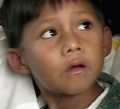 |
C H I L D R E N |
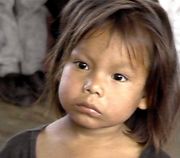 |
technofile
Al Fasoldt's reviews and commentaries, continuously available online since 1983
A photographic journey along Peru's Amazon basin
C H I L D R E N
O F T H E
R I V E R
Essay and photos by Al Fasoldt and Nancy FasoldtCopyright © 2000-2002, Al Fasoldt and Nancy Fasoldt. All rights reserved.
You are free to share this work, but you must ask permission if you intend to use this essay or the photographs it contains commercially. Choose the e-mail links above, or write to Al Fasoldt, The Post-Standard, Box 4915, Syracuse, NY 13221. This essay originally appeared on The Technofile, at twcny.rr.com/technofile.
Click on a photo for a larger version of most of the pictures. Brief information on each photo will be displayed if you place your mouse pointer over the photo and keep it there for a few seconds. All modern Web browsers should be able to display these captions.
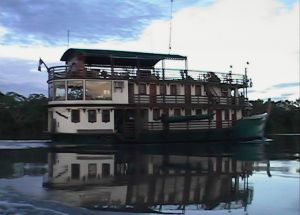
Our riverboat, La Esmeralda, glides along just before sunset on a stretch of the Amazon in Peru.
JOURNEY
We met these children of another world in a dozen villages along the Amazon River in May 1999. We were a few hundred miles east of Iquitos, an island city in northern Peru, on a 400-mile journey upriver with 14 other Americans on a diesel-powered riverboat named La Esmeralda -- "The Emerald."We sang to them in a schoolhouse and they sang to us; we laughed with them and tossed balloons for them to catch. They are beautiful children, as you will know from these photographs.All children are beautiful. Perhaps these Amazon children seem especially photogenic because they still haunt our consciences. With their Amazon homeland under attack from the inexorable forces of an urbanized society, the children of the river hold something we will never be able to attain again. We call it "innocence" because we know no other name. But a better word could well be "magic." When it passes your way, you hold it tightly, and you never want to let it go.
What they gave us in return is something just as simple, something lovely and joyous. These photos pay tribute to the magic we embraced in those Amazon villages so far from home.
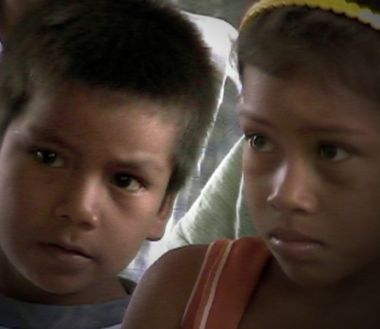
In the camcorder images, we took great care to preserve tonal values, especially in dark areas of the photos. Most computer monitors are adjusted with far too much brightness, so if you haven't adjusted yours properly so you might want to turn the brightness control on your monitor down until the boy's face in the adjoining photo is quite dark on one side and the girl's face seems to fade to a very dark brown at the edge of the photo. Then turn the contrast up to just below its maximum and fiddle with the setting until the image looks right to you. Be sure to keep room lights dim when you do this.
If your computer cannot show more than 256 colors, these pictures will look bad. Every modern PC or Macintosh can display more than 256 colors. Use the Control Panel to check the display settings and change them if necessary.
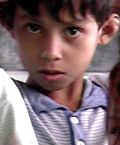
VILLAGESWe visited a school on our first trip ashore. Everybody in the village headed for the schoolhouse, and the teacher delivered an impressive speech to welcome us. Of the 16 North Americans there, only one of us spoke good Spanish, so one of our native guides translated her remarks. This drew the full attention of every child in the one-room school, apparently from the fascination of hearing a fellow countryman burst into animated North Americanisms in what they must have deemed perfect English. The boy and girl in the larger photo above were listening to the translated speech. The boy with the big ears and clear eyes kept waiting for our pocket camcorder to flash at him, but we were taking natural-light photos at that time. (Much of the school was dark, so we had no choice but to use flash for some of the photos.)

Our guides brought gifts for the children, for their teacher and for others in the village, including a 20-year-old in a blue dress who wore a pout until our little boat's captain started paying attention to her. When we left, her sad face arranged itself again, but this time she had a far-away look in her eyes.
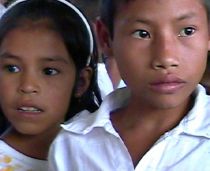
The children lined up after the speeches for songs. They sang what sounded like an anthem of political togetherness -- we heard the names of all of Peru's neighbors in one of the verses -- and we sang "Row, Row, Row Your Boat." For all we knew, the stirring anthem the children sang to us could have been a Peruvian equivalent of our North American nonsense ditty, and the children might have wondered if the song we sang with the repeated "oh" sounds had something to do with patriotic occassions.
Then our guides started blowing up balloons and the rest of us joined in. We tossed the balloons as high as we could, and the children squealed and jumped and stretched and jumped some more, as much for pure fun as for capturing balloons; most of them got away. We tossed the balloons as high as we could, and the children squealed and jumped and stretched and jumped some more, as much for pure fun as for capturing balloons; most of them got away.
Months later, examining some of the photos taken during these moments, we noticed something interesting: In many of the photos, older brothers and sisters can be seen lifting up their siblings to help them reach for the balloons. This was not a bunch of kids leaping for prizes; it was a community of Amazon children, helping each other in the same way their families help each other with the fishing and the palm cutting.
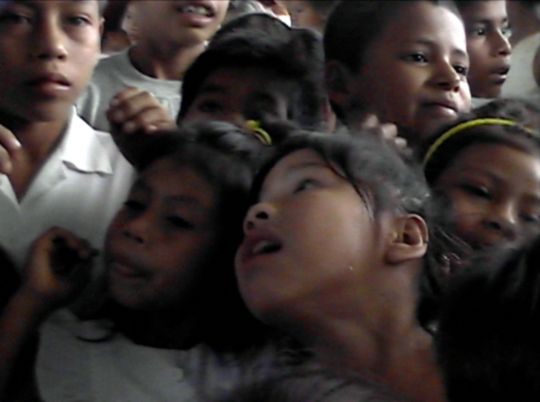
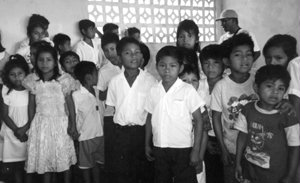
Photographers sometimes know intuitively that some scenes work better in black and white. This scene is one of them. Color distracted from the expressions on the faces of these village children, so we chose this format. (Of course, "black and white" actually means gray scale, so this photo and the larger one linked to it are shown in a full range of grays.)
BROTHERS
Ucile Vasquez Flores, one of our two native Peruvian guides -- the other was Daniel, his older brother -- was a natural clown. The kids loved him. He was at once a leader and a fellow adventurer.
Here you see him at his best. In one of the villages, Ucile shows off a rhinoceros beetle. The men of the village were keeping the dead beetle around to show visitors, so Ucile made a big production out of displaying the bug. He did it with only half a heart; beetles are just too common. Notice the little girl with her new balloon, ignoring Ucile.
Iquitos is an island city of 400,000, reachable by dugout canoe, motorboat, barge, airplane and, probably, teleportation. (We wondered how the huge buses that came for us at a quay off the harbor got there, and that was one of the responses. They no doubt had a more normal kind of trip, arriving by barge in most cases.)
Daniel and Ucille were born in a small village along the river, but moved to Iquitos as children when their father found a better job there. Both spoke English extraordinary well.
ANGEL
At one school, a little girl too young for regular classes wandered in front of the older kids to get a better view of a rodent called a capybara that one of the kids carried around as a pet. (You can't see it from the view here, but the animal has a tiny collar of sorts attached to one leg. Capybaras grow to 160 lbs., so that collar or a leash of some kind probably makes more sense than we realize.)While the teacher was describing a song the class was about to sing, the capybara greeted Nancy and the little girl stood transfixed. We fell in love with the child instantly, and have kept her picture handy. To look like an angel and act like an innocent child would seem, to those of us spoiled by our comfortable lives of cars and televisions and microwave ovens, to be an unobtainable goal. Yet the angel of that Amazon village haunts us still.
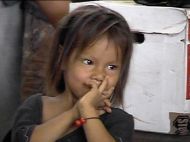
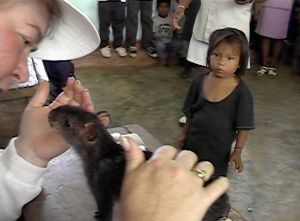
In the Amazon basin villages we visited, men and women shared much more of their daily tasks than they do in a typical household in the United States, yet a discerning eye could catch a different kind of role differentiation, as present in the rain forest as in the streets of suburban neighborhoods far to the north.
Boys in the villages were waiting. It was not clear what they were waiting
for. They were simply waiting, "holding up the side of the wall," with
dreams in their eyes and nothing for their hands to do. Cowboys on Montana
street corners looked like that a century ago.
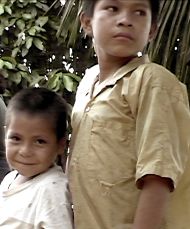
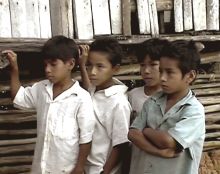
VISITORS
by Al Fasoldt
We were fishing for pirranha when a mother and daughter paddled up alongside our clunky skiff. At first, we figured they were showing up for bread, which our riverboat chef baked daily. But we were wrong. They had been attracted to the only excitement that weekday morning, so they parked their dugout canoe and watched. The little girl had a blue pail for fish bait, but the hour was wrong for serious fishing and the weather had just turned warm and sunny after a wash-away-your-blues kind of Amazon rain. So they drifted a few feet and floated into the low canopy and watched us without saying a word. We watched, too.


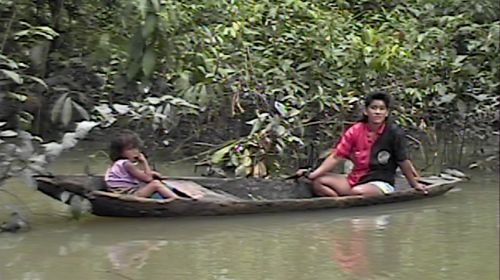
GREETINGS
Nothing had prepared us for the warmth of 500 smiles and the laughter in a thousand eyes in a village we took the "big boat" to. Most of the time our high-decked riverboat couldn't fit into the shallow loading pools villages used for harbors, but we were able to steam right up to one of the largest villages along the middle Amazon. The left photo of the two below shows La Esmeralda docked right at the edge of town.In that photograph, the children are lining up (by age, mostly, although many of them switched places after a few minutes to line up by height) and are getting ready to sing us a Peruvian song.
You can glimpse my favorite little boy in all of Peru in both photos. In the right picture, he's clasping his hands waiting to join the applause he knows will come after the song is over (it hasn't even begun yet at this point), and in the left photo, you'll see that he's doing the same thing. He walked around all afternoon waiting for the sound of applause so he could join in.
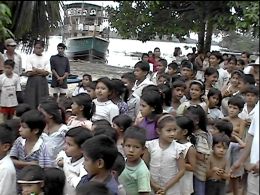

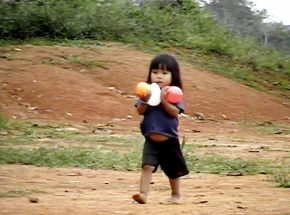
THE PATH
Leading away from the big village where we had been able to dock the riverboat was a dirt path that curved away from the shore. The greens of the trees and the warm browns of the plain earth caught our attention while the schoolchildren were gathering to serenade their visitors. Our guides handled out balloons, a favorite reward for children all along the waterway. We noticed a little girl wearing knee-length shorts bobbing down the path, away from a small marketplace at the center of the village, carrying her own red balloon and two others for the rest of her family. We snapped a couple of pictures as she walked away. But then the girl realized she was going in the wrong direction -- her family was still down by the market square -- and she turned around, heading resolutely back down the path. We had the picture we thought we'd never see.

WATERFarther along, in the lee of a flooded fishing outpost, we passed three boys in their dugouts. The hollowed-out logs that are charred and cut into dugout canoes are the bicycles and little red wagons of the Amazon, and we saw more dugout canoes piloted by children than by adults. If you were to visit any North American suburb in late spring, you'd see more bicycles ridden by children than by adults, too. The tree in this photo is growing straight up out of the river, which seems crazy if you haven't seen how the Amazon basin fills up in the rainy season. In the wet time, the river is everywhere, flooding so much area that Texas could fit inside without much notice. In the dry time, the waters fall back and expose a real landscape. The waters were higher than usual when we visited in May 1999; there was 55 feet of brown, flowing Amazon between the boys in this photo and the earth.
LIGHTSHOW
WE NEVER got tired of Amazon sunsets. Humid air and the soaring sky gave the gods of the setting sun a stage for spectacular effects. As much to show off our little camcorder as to share that stage production with you, we're including a frame from the digital camcorder's 15-minute movie of the sunset on a weekday evening. Parrots chattered and cried out continuously while the sky reddened and the clouds caught fire.

ETC.
We took many more photos, but decided to limit our essay to the few shown here. Life is too busy and time is too short for long expositions. We hope our brief essay helped make your busy world a little less mundane by opening a window on life along a small part of a very big river.Al Fasoldt
Nancy FasoldtApril 2000
technofile
Al Fasoldt's reviews and commentaries, continuously available online since 1983